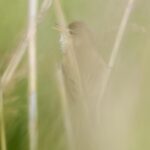Day 1 of another three day long weekend of tours today. We spent the day in North Norfolk, trying to catch up with a few of our local wintering specialities and lingering rarities. It was a glorious morning to be out – bright and crisp after a frost overnight, with big blue skies spread out above us. Even though it clouded over later in the afternoon, the forecast rain very kindly held off until after we had finished.
On our way down to the coast, a Barn Owl was out hunting over the grass beside the road, where the frost had melted. Our first stop was along the road at Holkham and the first bird we set eyes on there was another Barn Owl out hunting over the grazing marshes. There were several Marsh Harriers circling over the fields and a single one perched in the morning sun in a tree in front of us. Several Common Buzzards came out of the Park behind us and circled up into the sky.
Then a Peregrine appeared over Decoy Wood. It circled out over the pools, scattering all the masses of Wigeon, Teal and Shoveler, seemingly just for fun, then drifted back over the trees again. Next it dropped down towards the grass and had a go at an Egyptian Goose which happened to be flying past. It landed on one of the trees for a brief rest and then dropped down over the back.
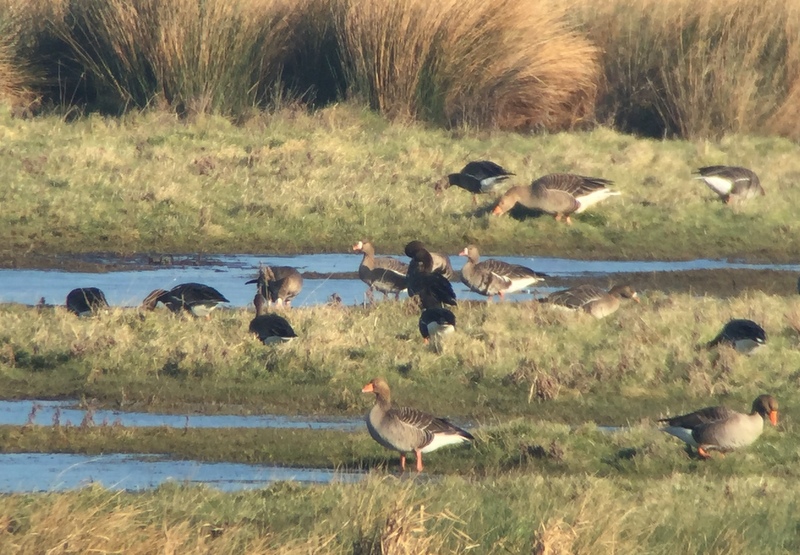 White-fronted Geese – with a few Greylags for company
White-fronted Geese – with a few Greylags for company
There were still a good number of White-fronted Geese out on the freshmarsh. Many of them were hidden behind the trees, which made it difficult to count them today, but several were out in the open where we could get a good look at them, admiring the white surround to the base of their bills and their black belly stripes. There were several much larger Greylag Geese with them, giving a good opportunity for comparison.
A lone Ruff was down on the grass by one of the small pools and there were lots of Lapwing there too. A small party of Black-tailed Godwits whirled round whenever one of the Marsh Harriers drifted over.
We made our way on westwards and stopped by the harbour at Burnham Overy Staithe. It was a wonderful day to be walking out along the seawall. The mud along the harbour channel was full of waders – Redshanks, Grey Plover, Dunlin. A group of Black-tailed Godwits were roosting on one of the sandbars, at least until they were flushed by a couple of dogs. Several are already starting to acquire the orange breast feathers of summer plumage. We couldn’t find a Knot with them on the way out, but remedied that later, on the way back.
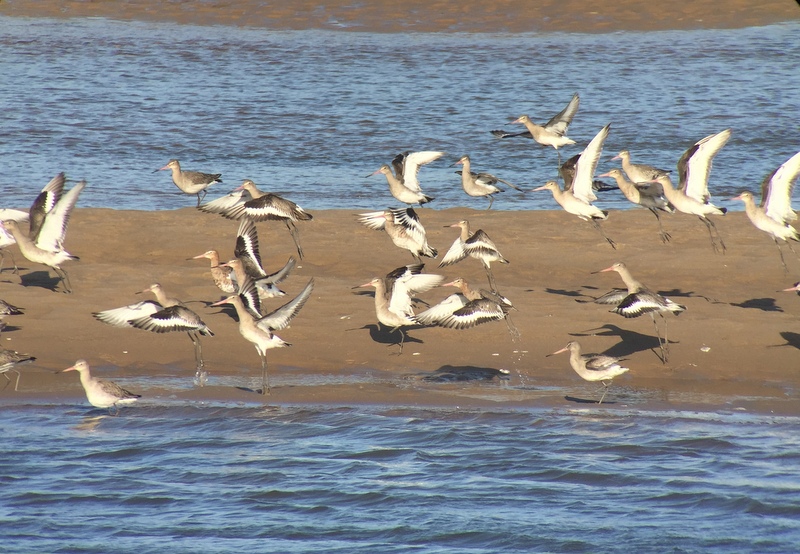 Black-tailed Godwits – flushed from the sandbank in the harbour
Black-tailed Godwits – flushed from the sandbank in the harbour
All the Brent Geese which had been loafing around in the harbour were flushed by the dogs too and flew off out across the grazing meadows to feed. A couple of Red-breasted Merganser swam away, diving constantly, and later flew back to where they had been feeding, once the danger had passed.
We stopped on the seawall to have a closer look at some Pink-footed Geese. Most of them seem to have departed already, on their way further north where they will stop a while before continuing on to Iceland. However, there are still groups hanging around so we wanted to take this opportunity to have a proper look.
At this point, our attention was drawn to a black bird circling low over the edge of the dunes. It is always hard to judge the size of a lone bird, but it looked big, really big. There was also something about the way it was flying, circling effortlessly. We swung the scope round onto it quickly and could see a huge black bill, thick neck, with shaggy feathering at the throat and what seemed to be a longish wedge-shaped tail – a Raven!
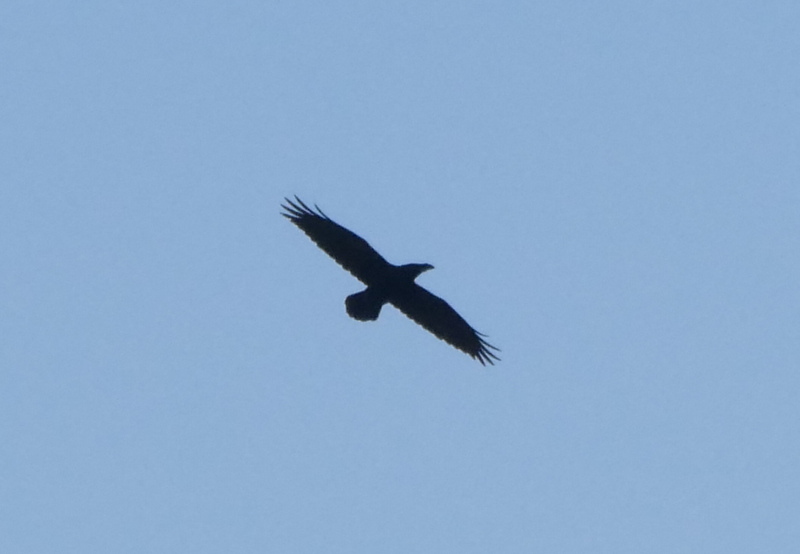 Raven – one of a pair in the dunes today, a properly rare bird in Norfolk!
Raven – one of a pair in the dunes today, a properly rare bird in Norfolk!
In some parts of the country, a Raven would not create much excitement, but they are still really rare in Norfolk. So much so, that this was the first Raven that your correspondent has ever seen in his home county! They have been spreading across the country and records here have been increasing in the last couple of years, but it is still a great bird to see here.
It was joined by a second and the two Ravens circled slowly along the dunes towards Holkham Pines. At this point, two Carrion Crows set off after them and started to mob them – the Crows were tiny by comparison. One of the Ravens started to circle out over the grazing marshes towards us, and we could now hear the deep, hoarse ‘kronk’ call. It got nearer and nearer and looked like it would come straight to us before it swung away again towards Holkham Park. Great stuff!
With a spring in our step, we carried on out towards the dunes, and turned west along the beach towards Gun Hill. We had come to look for the Shore Larks, so we looked carefully all the way along the high tide line where they like to feed. We couldn’t find them. There were a few Ringed Plovers on the beach and several Sanderlings with the Oystercatchers down by the channel.
At the end of the dunes, opposite Scolt Head island, there was no sign of the Shore Larks on the piles of seaweed and other dead vegetation where they like to feed. A small group of Goldeneye took off from the channel as we approached. We had a good look round the edge of the dunes on the inland side as well, without any joy. It seemed like we were out of luck – the Shore Larks had apparently been present earlier in the morning but had obviously been disturbed and flown off.
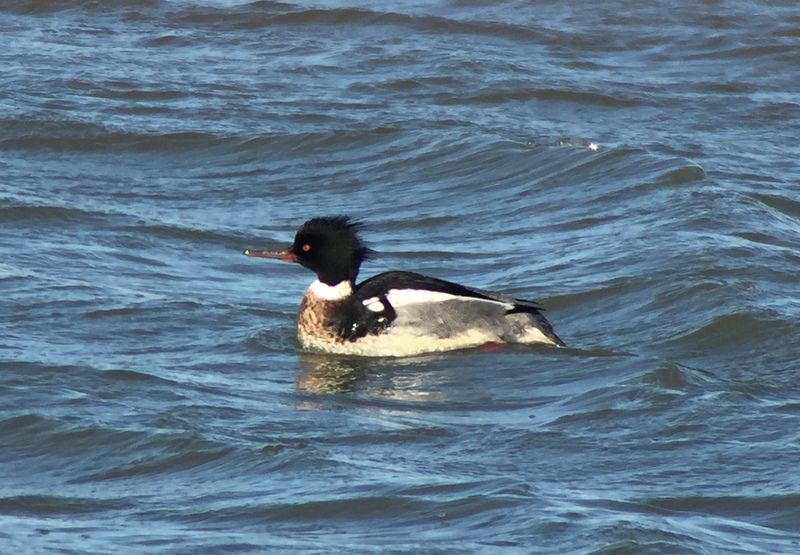 Red-breasted Merganser – in the harbour channel opposite Gun Hill
Red-breasted Merganser – in the harbour channel opposite Gun Hill
We started the long march back, stopping to admire a little party of Red-breasted Mergansers in the harbour channel, including a smart drake this time. We walked out onto the beach to check the lines of debris washed up by the tide. We had just given up and decided to move on when three small birds flew along the edge of the dunes towards us – the Shore Larks!
They carried on past us, along the beach the way we had just walked, and appeared to land. It was too much to resist, so we walked back up the beach again to try to see them. There were two walkers with a dog ahead of us, the latter scampering along the high tide line, and we had to race to catch them up. They very kindly agreed to get their dog under control, almost too late as it flushed the Shore Larks before they could call it back (apparently the dog was deaf, which didn’t help!). Thankfully they landed again a few metres further on and the dog was duly restrained. We all had a good look at the Shore Larks in the scope – including the dog owners.
 Shore Lark – the three eventually flew back in just as we were giving up
Shore Lark – the three eventually flew back in just as we were giving up
The Shore Larks were feeding very quietly around the piles of dead vegetation on the edge of the beach, working their way slowly along. We admired their bright yellow faces with black masks. Then we noticed another dog walker coming back along the beach and, despite being spoken to by someone watching the Shore Larks from opposite us, he carried straight on with his dogs and the Shore Larks flew off again back down the beach.
Having had great views of them now, we decided to call it a day and walk back. On our way, we came across the Shore Larks further down the beach, hiding in amongst the stones. They were obviously waiting for their favoured feeding area to be left undisturbed as, after a few minutes, they flew back again to where they had been feeding. We left them in peace – though for how long they might be able to enjoy that we could not say.
 Shore Lark – constantly getting disturbed today
Shore Lark – constantly getting disturbed today
We stopped to admire the Golden Plovers on the open grass below the dunes again. There were loads of them – probably at least 1,000 – mostly standing still head into the breeze. Then we made our way back to the car.
We were running a bit later than planned, after we had finally caught up with the Shore Larks. We made our way on further west to Brancaster Staithe. Before we even got out of the car, we could see the Red-necked Grebe in its favoured place, further up the channel. It was diving regularly, but we got it in the scope and had a good look at it.
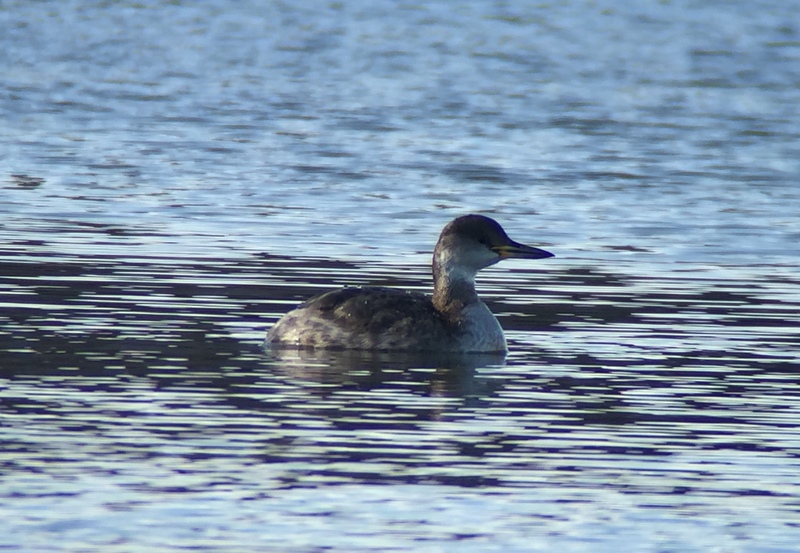 Red-necked Grebe – in Brancaster Staithe harbour channel again
Red-necked Grebe – in Brancaster Staithe harbour channel again
There was a female Goldeneye diving nearby and a Little Grebe too for good measure. The tide was still pretty low, and surprisingly there were no Bar-tailed Godwits here today. However, there were several Black-tailed Godwits, plus lots of Dunlin, Turnstone and Oystercatcher.
After an action packed morning, we had a late lunch at Titchwell before a quick look round as much of the reserve as we could manage in the time available. The feeders by the visitor centre were busy with birds as usual – lots of Chaffinches, several Goldfinches, and a few Greenfinches – although several were already empty. A single female Brambling was struggling to find a feeder port with any food left!
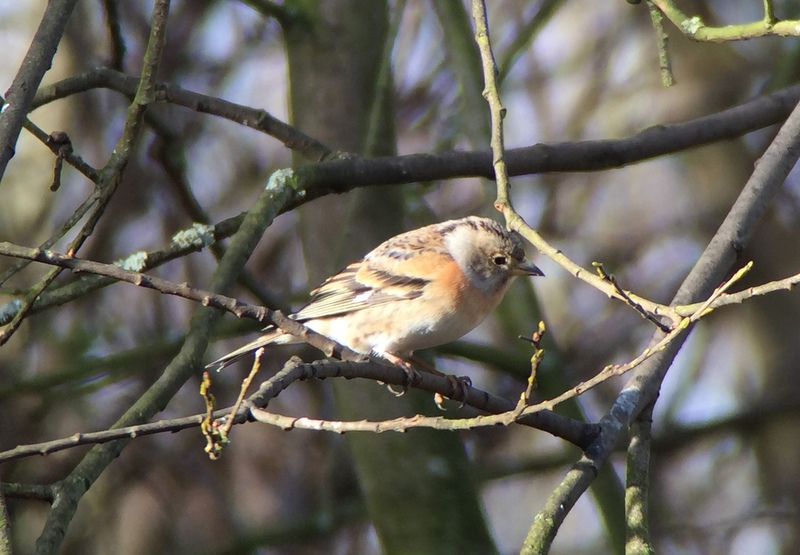 Brambling – just one female today, while we were looking
Brambling – just one female today, while we were looking
Out from the main path, the Water Rail was hiding in the shadows under the brambles on the far bank of the ditch. Eventually it came out a little more into the open, probing round in the rotting leaves for something to eat.
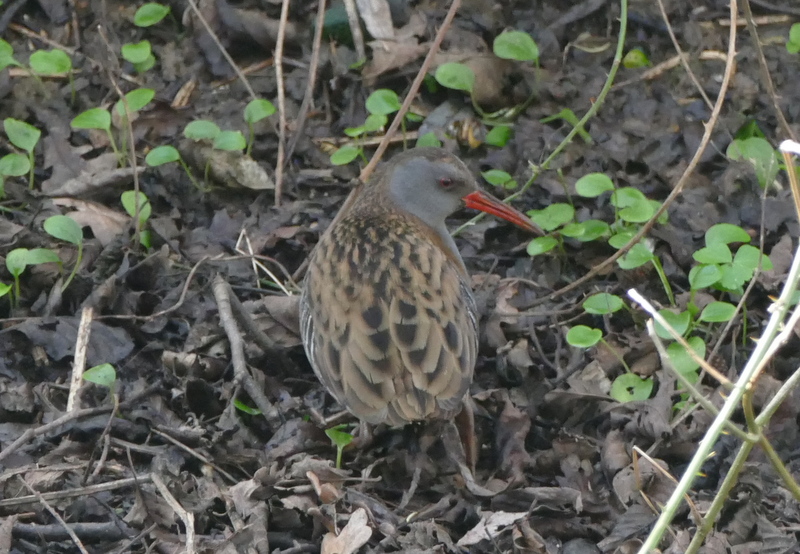 Water Rail – in the ditch, as usual
Water Rail – in the ditch, as usual
The first bird we saw on the dried out grazing meadow ‘pool’ was a Water Pipit, quite close to the path down at the front. It was looking particularly clean, bright white below in the sunshine today. A couple of Rock Pipits nearby were noticeably swarthy by comparison. Further over, towards the back, a second Water Pipit appeared with yet more Rock Pipits. The raft of Pochard and Tufted Duck was still on the reedbed pool.
The water level on the freshmarsh is still low for management work. There is a reasonable number of waders on here, particularly Dunlin, plus about 40 Avocet and several Black-tailed Godwit. A hundred or so Golden Plover were on one of the drier islands, along with a scattering of Lapwing.
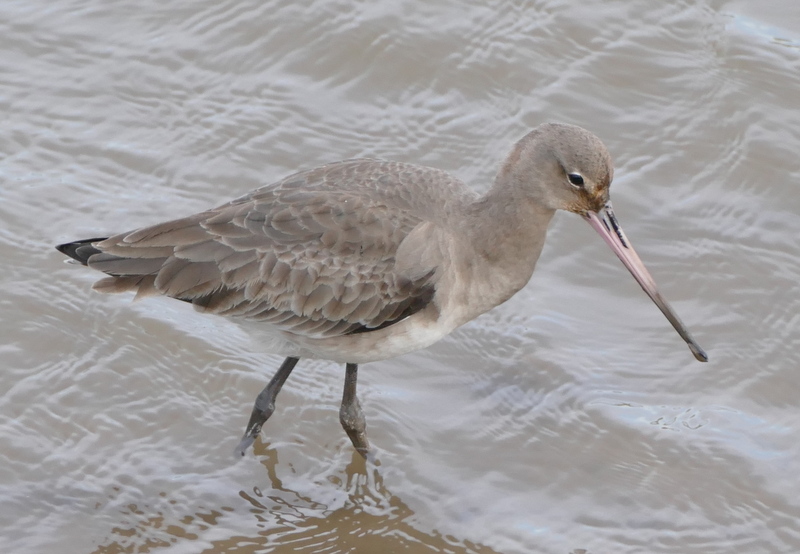 Black-tailed Godwit – always good to see up close at Titchwell
Black-tailed Godwit – always good to see up close at Titchwell
Most of the Teal are still over the back of the freshmarsh, around the remaining deeper water, but a few were close to the main path where we could get a better look at them. The drakes are looking particularly smart at the moment. Other than that, there were a few Gadwall and Mallard and a handful of Wigeon scattered around.
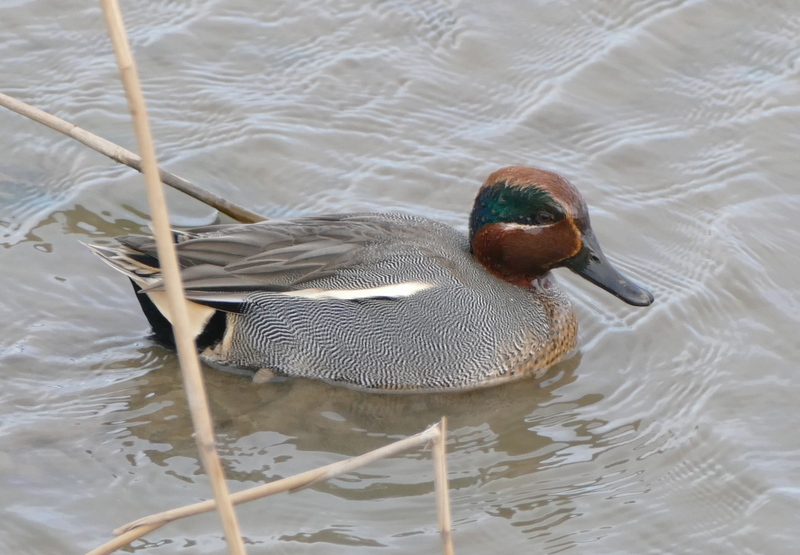 Teal – a smart drake
Teal – a smart drake
The Volunteer Marsh held a couple of Knot and a little group of Ringed Plover, as well as the usual Curlew, Redshank and Grey Plover. The brightest Ringed Plover, presumably a spring male, was very aggressive in chasing the others off.
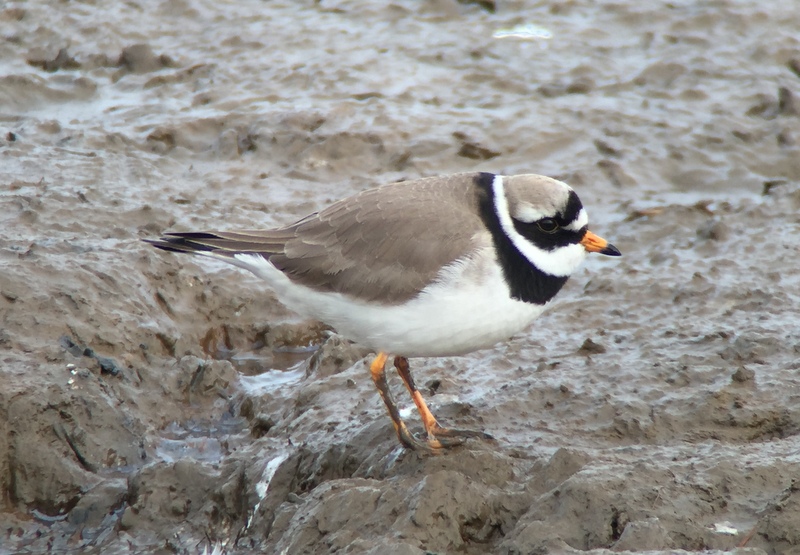 Ringed Plover – a bright spring bird
Ringed Plover – a bright spring bird
A few Black-tailed Godwit and a single Avocet were down in the deeper channel by the path. At the back, we finally found our first Bar-tailed Godwit of the day, but we got better views of them around the Tidal Pools. Again, we had a discussion about how to separate the two similar Godwit species.
 Bar-tailed Godwit – there were a few round the Tidal Pools today
Bar-tailed Godwit – there were a few round the Tidal Pools today
We just had time to admire the Pintail, swimming around on the Tidal Pools. We got a cracking drake in the scope for a quick close-up. Then it was time to make our way back – we had somewhere else we needed to be!
 Pintail – one of the drakes on the Tidal Pools
Pintail – one of the drakes on the Tidal Pools
We drove across inland and managed to just about find a space this evening in the car park at Roydon Common. As we arrived, the news came through that the Pallid Harrier had already flown in to the heath ahead of going to roost. We quickened our step one last time and made our way across to the ridge.
The Pallid Harrier was down in the grass when we arrived but promptly took off for a fly round. We had it in the same scope view as a ringtail Hen Harrier, the two having a quick go at each other. The Hen Harrier was noticeably bigger and heavier, with broader wings with more obviously rounded tips. It was great to see the two species together.
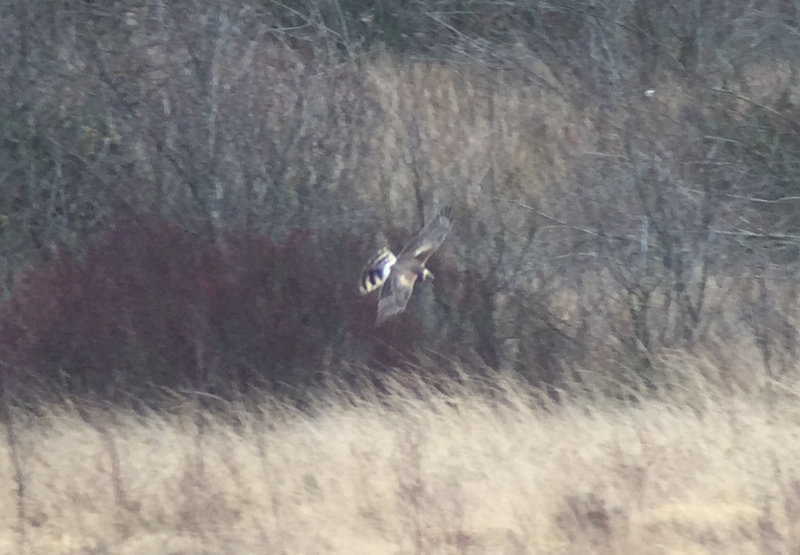 Pallid Harrier – still roosting at Roydon Common today
Pallid Harrier – still roosting at Roydon Common today
The Pallid Harrier circled up high into the sky this evening, and spent some time flying back and forth way up above the trees. When it came down, against the background of the birches, we could see its pale collar better, and the contrasting dark neck patch, the ‘boa’. It landed a couple of times and we could see it half hidden in the grass the first time.
A second ringtail Hen Harrier flew in as well, but dropped down pretty quickly into the grass. It was rather cloudy now and there were just a couple of spots of rain. When the Pallid Harrier dropped down to the ground again, we decided to call it a day and head for home.
A short video clip of the Pallid Harrier in action from today is below:
